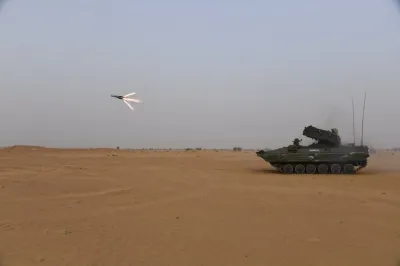Has the Defence Ministry Approved Military Hardware Purchases Worth Rs 79,000 Crore?

Synopsis
Key Takeaways
- Defence Acquisition Council approves military hardware worth Rs 79,000 crore.
- Significant enhancements to the Army's operational capabilities.
- Acquisitions will bolster the Navy's ability for amphibious operations.
- New systems will improve Air Force effectiveness in missions.
- Focus on indigenous development of military technology.
New Delhi, Oct 23 (NationPress) The Defence Acquisition Council, during a meeting on Thursday led by Defence Minister Rajnath Singh, sanctioned an array of proposals from the Army, Navy, and Air Force for the acquisition of military equipment valued at approximately Rs 79,000 crore.
For the army, the Acceptance of Necessity (AoN) was granted for the procurement of the Nag Missile System (Tracked) Mk-II (NAMIS), Ground-Based Mobile ELINT System (GBMES), and High Mobility Vehicles (HMVs) equipped with Material Handling Cranes, as per an official announcement released after the meeting held at the South Block.
The acquisition of the tracked NAMIS will bolster the army's ability to neutralize enemy combat vehicles, bunkers, and other field fortifications, while the GBMES will ensure continuous electronic intelligence on enemy emitters. Additionally, the introduction of HMVs will significantly enhance logistical support to forces across various geographical terrains, the statement elaborated.
For the navy, the AoN was authorized for the acquisition of Landing Platform Docks (LPD), 30mm Naval Surface Gun (NSG), Advanced Light-Weight Torpedoes (ALWT), Electro-Optical Infra-Red Search and Track System, and Smart Ammunition for 76mm Super Rapid Gun Mount.
The procurement of LPDs will allow the Indian Navy to conduct amphibious operations alongside the army and air force. The integrated maritime capabilities provided by the LPDs will also enable the Indian Navy to engage in peacekeeping missions, humanitarian assistance, and disaster relief.
The ALWT, developed locally by the Naval Science & Technological Laboratory at DRDO, is adept at targeting both conventional and nuclear submarines. The acquisition of the 30mm NSG will enhance the operational capacity of both the navy and the Indian Coast Guard in low-intensity maritime operations and anti-piracy efforts, according to the statement.
For the air force, the AoN was approved for the Collaborative Long Range Target Saturation/Destruction System (CLRTS/DS) and other related proposals. The CLRTS/DS is designed to autonomously take off, land, navigate, detect, and deliver payloads in mission areas, the statement concluded.









